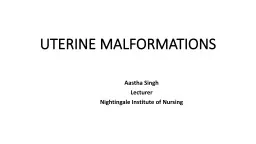

Lecturer Nightingale Institute of Nursing Introduction Uterine malformations result from partial or complete failure of one of three mechanisms either separately or combined agenesis fusion and resorption ID: 915150
Download Presentation The PPT/PDF document "UTERINE MALFORMATIONS Aastha Singh" is the property of its rightful owner. Permission is granted to download and print the materials on this web site for personal, non-commercial use only, and to display it on your personal computer provided you do not modify the materials and that you retain all copyright notices contained in the materials. By downloading content from our website, you accept the terms of this agreement.
Slide1
UTERINE MALFORMATIONS
Aastha Singh
Lecturer
Nightingale Institute of Nursing
Slide2Introduction
Uterine malformations result from partial or complete failure of one of three mechanisms either separately or combined - agenesis, fusion, and resorption.
Agenesis
results in either a complete absence of the uterus or a
unicornuate
uterus;
a
failure to fusion
gives rise to uterine
didelphys
or a
bicornuate
uterus;
and a
septated
uterus is due to a
failure of resorption
.
Slide3Clinical Presentation
Spontaneous Abortion
Premature Delivery
Infertility
Abnormal Fetal Lie
Dystocia at delivery
Dysmenorrhea
endometriosis
Cervical incompetence
Slide4Classification into 3 groups
Based on similar embryonic development defects and clinical presentation
Agenesis of uterus/vagina:
RokitanskyKuster
-Hauser Syndrome
Defects in Vertical Fusion (obstructive or non-obstructive)
Lateral Fusion defects (obstructive or non-obstructive)
Slide5Müllerian duct anomaly classification
The American Fertility Society (AFS) classified
muellerian
anomalies according to the major uterine anatomic types:
Hypoplasia/agenesis
Unicornuate
Didelphys
Bicornuate
Septate
Arcuate
Slide6Arcuate:
The uterus appears normal from the outside but has a very small (1cm or less) indentation protruding from the top of the uterine cavity. This is generally unproblematic. It is simply considered a different, but perfectly normal, type of uterus.
Bicornuate
:
This uterus is considered heart-shaped. It has a deep indentation at the top of the uterus, forming an overall shape of a heart.
Septate
:
This uterus appears normal from the outside, but it contains an internal septum that divides the uterine cavity into 2 smaller cavities.
Slide7Didelphys
:
The two halves of the uterus are completely separate.
Unicornate
:
Only one-half of the uterus is well-developed.
Slide8CLASS I: UTERINE AGENESIS/UTERINE HYPOPLASIA
a: vaginal (uterus: normal/ variety of abnormal forms) –
b: cervical
c: fundal
d: tubal
e: combined
Slide9CLASS II: UNICORNUATE UTERUS/UNICORNIS UNICOLLI
a: communicating contralateral rudimentary horn contains endometrium
b: non-communicating contralateral rudimentary horn contains endometrium
c: contralateral horn has no endometrial cavity
d: no horn
Slide10CLASS III: UTERUS DIDELPHYS
This condition exists when a woman has two separate uterine bodies, each one with a cervix.
Slide11CLASS IV: BICORNUATE UTERUS
A. complete division, all the way down to internal the
os
–
b: partial division, not extending to the
os
Slide12CLASS V: SEPTATE UTERUS
a: complete division, all the way down to the internal
os
b: incomplete division
This is the commonest anomaly
Slide13CLASS VI: ARCUATE UTERUS
An arcuate uterus is characterized by a mild indentation of the endometrium at the uterine fundus. It occurs due to failure of complete resorption of the
uterovaginal
septum
Slide14UTERINE AGENESIS
Uterine agenesis is the extreme of
Mullerian
duct anomalies (Class I) where there is complete absence of uterine tissue above the vagina.
Epidemiology
: The uterine agenesis-hypoplasia spectrum accounts for ~10-15% of all
Müllerian
duct anomalies.
Clinical presentation
: is
characterised
by primary
amenorrhoea
, with normal hormonal levels guaranteed by fully functional gonads.
Complete absence of the
Mullerian
ducts is termed
Mayer-
Rokitansky
-
Kuster
-Hauser (MRKH) syndrome
which includes absence of the vagina as well
Slide15Mayer-Rokitansky
-
Kuster
-Hauser (MRKH) syndrome (Utero vaginal
agensis
Expected Menarche
Difficult to differentiate from imperforate hymen
No uterus on exam, U/S, MRI, Laparoscopy, IVP
Confused with Androgen Resistance Syndrome with shallow pouch and no uterus
Slide16UNICORNUATE UTERUS
Unicornuate
with uterine horn (not containing an endometrial cavity, not fused to cavity
Unicornuate
with communicating uterine horn
Slide17 Complications of the Mullerian
duct anomalies
Spontaneous abortion
Reported premature birth
Infertility
Slide18Symptoms of Uterine Malformations
Uterine malformations usually present with no symptoms at all. Some women with malformed uteruses don’t have difficulty getting pregnant and do not usually discover their unusually shaped uterus until they have a prenatal ultrasound. Others may be diagnosed during an infertility evaluation.
Slide19Diagnosis
A complete medical history and physical examination may lead us to suspect that a congenital uterine anomaly is present. However, imaging studies, such as a
hysterosalpingogram
(HSG) and ultrasound, or an MRI are required to
visualise
the uterus and confirm that a congenital uterine anomaly is present
MRI has been the "gold standard" for categorizing uterine
anomalie